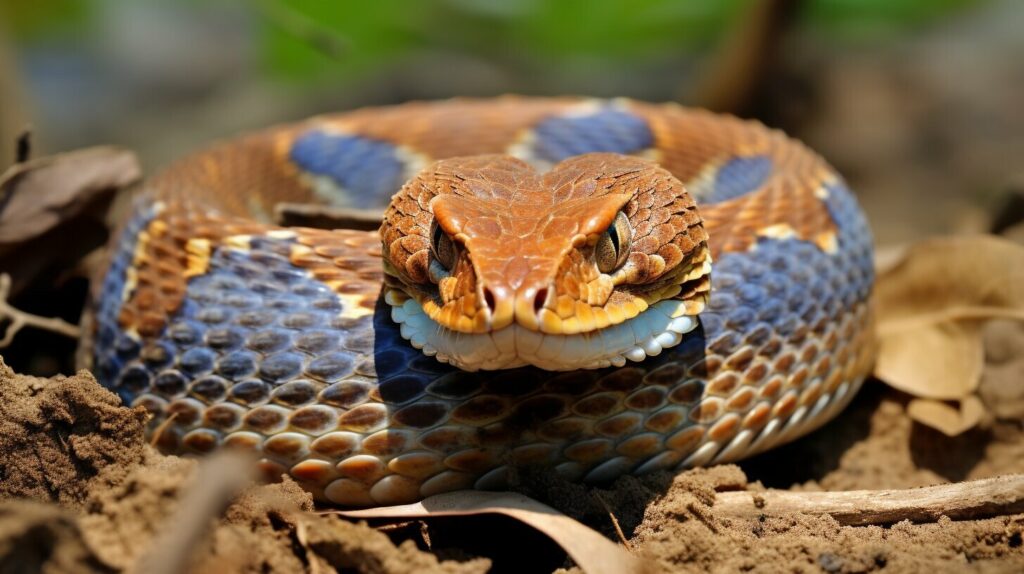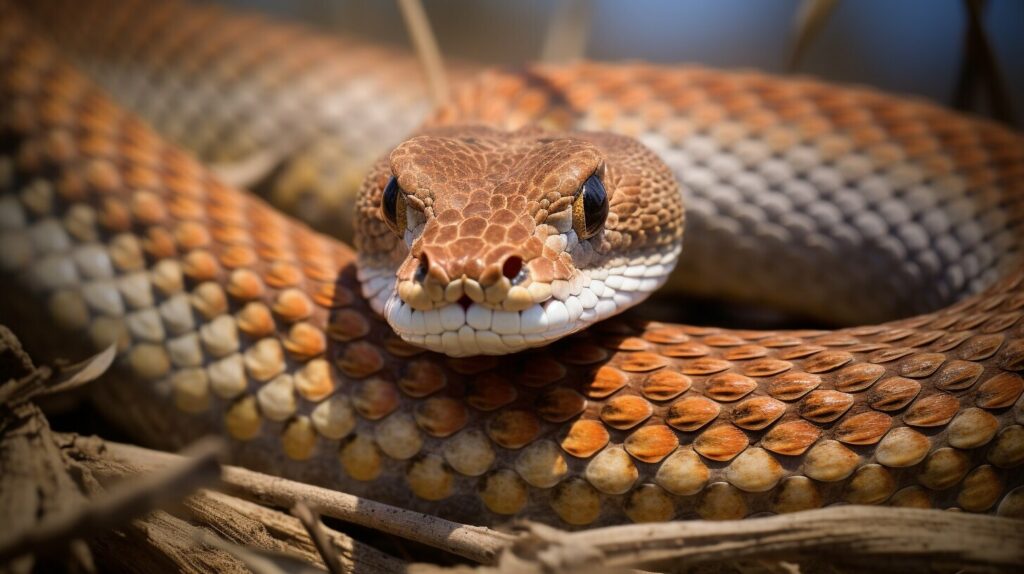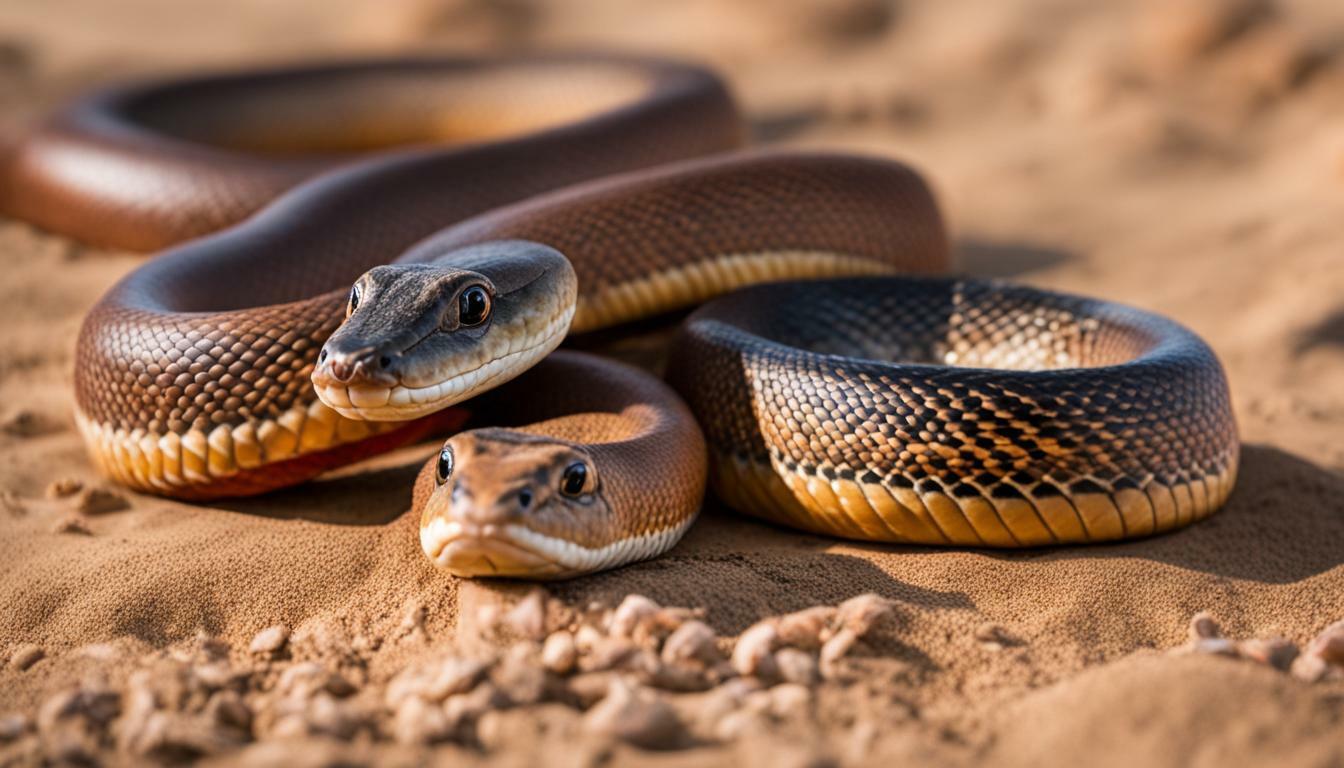When it comes to venomous snakes, understanding the difference between rattlesnakes and copperheads is essential for safety and knowledge. These two species, although belonging to the same family of pit vipers, have distinct characteristics and behaviors that set them apart. By familiarizing ourselves with these differences, we can better navigate their habitats and reduce the risk of accidental encounters.
Key Takeaways:
- Rattlesnakes and copperheads are both venomous snakes, but they have different patterns of behavior and physical traits.
- Proper snake identification is crucial for avoiding confusion between the two species.
- Rattlesnakes have a rattle at the tip of their tails, which they use as a warning signal. Copperheads lack a rattle.
- Coloration and pattern are important factors in differentiating between rattlesnakes and copperheads.
- Understanding the venomous properties of both snakes is essential for recognizing the risks associated with their bites.
- There are various species of rattlesnakes and subspecies of copperheads, each with its own unique characteristics and geographical distribution.
When it comes to snake identification, there are several key factors to consider, including physical characteristics and behavior. While color alone is not the most reliable method for identification, the patterns on the snakes‘ bodies can provide important clues. Rattlesnakes and copperheads have distinct patterns that can help differentiate them.
Rattlesnakes, as the name suggests, have a unique rattle at the end of their tails. This rattle serves as a warning sign and is a definitive feature of rattlesnakes. It’s important to note that rattlesnakes will hold their tails above the ground when moving, while copperheads’ tails trail along the ground. So, if you encounter a snake with a rattle, it is likely a rattlesnake.

Copperheads, on the other hand, have distinctive coloration and patterns. They typically have a pale tan to pinkish-brown color with darker crossbands. These crossbands often take the form of an hourglass pattern, with wider bands on the sides and a narrower band across the back. This unique pattern is a key characteristic of copperheads.
Another important factor to consider is snake behavior. Rattlesnakes are more likely to coil themselves and vibrate their rattles when they perceive a threat. This behavior serves as a warning sign to potential predators or humans. In contrast, copperheads may remain motionless when faced with a threat, making them more difficult to spot and identify.
It’s worth noting that copperheads are also known for delivering defensive bites, sometimes called dry bites, as a warning. While both rattlesnakes and copperheads are venomous, copperheads are more likely to deliver a bite without injecting venom. However, it’s crucial to treat all snake bites as potentially venomous and seek medical attention immediately.
To summarize, when identifying venomous snakes, pay attention to the presence of a rattle, patterns on the snake’s body, and their behavior. Rattlesnakes have a rattle at the end of their tails, while copperheads have distinctive hourglass patterns and may remain motionless when faced with a threat. However, it’s always best to exercise caution and keep a safe distance from any snake you encounter in the wild.
Habitat and Behavior: Where and How They Live
Rattlesnakes and copperheads may share similar regions, but their habitat preferences and behavior differ significantly. Understanding these differences is crucial for safely navigating snake habitats and reducing the risk of encounters. Let’s explore the unique characteristics of their habitats and how they interact with their surroundings.
Rattlesnakes: Adapted for Diverse Environments
Rattlesnakes are found throughout North America, from the deserts of the Southwest to the forests of the Northeast. They have adapted to a wide range of habitats, including grasslands, woodlands, mountains, and even swamps. One common characteristic of rattlesnake habitats is the presence of suitable shelter, such as rock crevices, logs, and burrows.
Rattlesnakes are ectothermic, meaning they rely on external sources of heat to regulate their body temperature. As a result, they are most active during warmer months and prefer sun-exposed areas where they can bask and absorb heat.
When it comes to behavior, rattlesnakes are ambush predators. They use their excellent camouflage to blend in with their surroundings and patiently wait for prey to come within striking distance. Rattlesnakes have exceptional patience and can wait for hours or even days without moving. Once a suitable target approaches, they strike quickly, injecting venom to immobilize their prey.
Copperheads: Masters of Camouflage
Unlike rattlesnakes, copperheads have a more limited geographic range, primarily found in the eastern and central regions of the United States. They exhibit a preference for forested areas, including hardwood forests, pine forests, and swampy regions.
Copperheads are also ectothermic and rely on external sources of heat. However, they are more tolerant of cooler temperatures, which allows them to inhabit regions where rattlesnakes may not be as common.
Copperheads employ a similar hunting strategy as rattlesnakes, relying on their camouflage and ambush techniques to capture prey. Their coloration, ranging from brown to pinkish-brown with darker crossbands, allows them to blend seamlessly into their wooded surroundings, making them difficult to spot.
It’s important to note that copperheads, being more wary and defensive, are more likely to retreat or remain motionless when faced with a potential threat. However, if provoked or cornered, they may strike without warning.
Key Takeaways:
- Rattlesnakes are found throughout North America in various habitats, while copperheads have a more limited range in eastern and central regions of the United States.
- Rattlesnakes prefer sun-exposed areas and require suitable shelter, such as rock crevices and burrows.
- Copperheads exhibit a preference for forested areas, including hardwood and pine forests.
- Both snakes are ectothermic and rely on external sources of heat, with rattlesnakes being more active during warmer months.
- Rattlesnakes and copperheads are ambush predators, using camouflage to blend in with their surroundings and striking quickly when prey comes within reach.
“Understanding the habitat preferences and behavior of rattlesnakes and copperheads is essential for promoting coexistence and reducing the risk of snake encounters.”
Appearance: Spotting the Telltale Signs
By closely examining their physical traits, it becomes easier to differentiate between rattlesnakes and copperheads. These differences are crucial in accurately identifying these venomous snakes and avoiding any potential dangers. Let’s take a closer look at the appearance of both snakes:
Rattlesnakes:
Rattlesnakes have several distinctive characteristics that set them apart from copperheads.
- Rattle: The most obvious feature of a rattlesnake is its rattle, located at the tip of its tail. This rattling sound is a warning sign and serves as a defensive mechanism when the snake feels threatened. It’s important to note that not all rattlesnakes have fully developed rattles, especially in younger individuals.
- Head Shape: Rattlesnakes have a triangular-shaped head, broader and more defined than their body. This shape is due to their venom glands, injecting venom through their long, hollow fangs.
- Pit Organs: Rattlesnakes possess heat-sensing pits located between their eyes and nostrils. These pits allow them to detect warm-blooded prey and aid in hunting.
- Coloration and Patterns: Rattlesnakes display a variety of coloration and patterns, depending on the species and individual. Common color variations include shades of brown, gray, or tan, often accompanied by dark, distinct bands or blotches along their bodies.
- Size: Rattlesnakes come in various sizes, ranging from a few feet to over six feet in length, depending on the species.
By being aware of these physical traits, you can identify a rattlesnake and take appropriate precautions when encountering one.

Copperheads:
Copperheads also have unique physical features that differentiate them from rattlesnakes.
- Coloration and Patterns: Copperheads have a distinct copper or reddish-brown color, hence their name. Their bodies are adorned with hourglass-shaped or zigzagging patterns, typically in shades of brown or tan, which provide them with effective camouflage in their natural habitats.
- Head Shape: Copperheads have a more rounded head, compared to the triangular head shape of rattlesnakes.
- Size: Copperheads are generally smaller than rattlesnakes, averaging between 20-37 inches in length.
- Pit Organs: Similar to rattlesnakes, copperheads possess heat-sensing pits between their eyes and nostrils, aiding in prey detection.
Remember, when encountered in the wild, it is always better to keep a safe distance from any venomous snake and avoid any potential interactions. If unsure of the snake’s identity, it’s best to observe it from a safe distance and contact local wildlife authorities for assistance.
Knowing the physical traits specific to rattlesnakes and copperheads allows for a better understanding of these venomous snakes and helps in distinguishing between the two. Always prioritize your safety and the protection of these snakes’ natural habitats.
Venomous Threat: Understanding Their Toxicity
Both rattlesnakes and copperheads possess venomous bites, but the nature of their toxins and their effects differ significantly. Understanding the toxicity of their venom is essential for assessing the potential risks associated with their bites.
Rattlesnake venom is known for its potency and can cause severe damage to tissues, blood vessels, and organs. The venom of rattlesnakes is primarily hemotoxic, meaning it affects the victim’s blood and circulatory systems. It contains enzymes and proteins that break down the victim’s tissue, leading to extensive swelling, bleeding, and potential necrosis.
On the other hand, copperhead venom is generally milder compared to rattlesnake venom. It also has hemotoxic properties but is less potent. Copperhead bites can still cause pain, swelling, and tissue damage, but the effects are typically less severe than those of rattlesnake bites.
It is important to note that the severity of the effects depends on various factors, including the snake’s size, the amount of venom injected, the location of the bite, and the individual’s immune response. Prompt medical attention is crucial in all cases of venomous snake bites to minimize potential complications.
Rattlesnake Species: Exploring the Varieties
Rattlesnakes encompass a diverse range of species, each with its own distinct traits and habitats. Let’s explore some of the different species of rattlesnakes and learn more about their unique characteristics.
Eastern Diamondback Rattlesnake
The Eastern Diamondback Rattlesnake (Crotalus adamanteus) is one of the largest species of rattlesnakes, often reaching lengths of up to 8 feet. It is known for its distinctive diamond-shaped patterns on its back, which give it its name. Found primarily in the southeastern United States, this species prefers dry habitats such as pine forests, sandhills, and coastal dunes. With its potent venom and large size, the Eastern Diamondback Rattlesnake is considered one of the most dangerous rattlesnake species.
Western Diamondback Rattlesnake
The Western Diamondback Rattlesnake (Crotalus atrox) is another large species of rattlesnake, commonly found in the southwestern United States and northern Mexico. It has diamond-shaped patterns on its back, similar to the Eastern Diamondback, but with more muted coloration. This species is highly adaptable and can be found in a variety of habitats, including deserts, grasslands, and rocky areas. The Western Diamondback Rattlesnake is known for its aggressive behavior and potent venom.
Mojave Rattlesnake
The Mojave Rattlesnake (Crotalus scutulatus) is a venomous rattlesnake species found in the southwestern United States and northern Mexico. It is known for its neurotoxic venom, which can cause paralysis and respiratory failure in its prey. The Mojave Rattlesnake has a distinctive dark diamond-shaped pattern on its back, often with lighter-colored bands. It prefers desert and arid regions, and can often be found in rocky areas and crevices.
Timber Rattlesnake
The Timber Rattlesnake (Crotalus horridus) is a large, heavy-bodied rattlesnake species found primarily in the eastern United States. It has a brown or grayish-brown coloration with dark crossbands along its body. The Timber Rattlesnake is known for its characteristic rattle, which it uses as a warning to potential predators. This species inhabits a variety of forested habitats, including deciduous forests and rocky outcrops.
Black-tailed Rattlesnake
The Black-tailed Rattlesnake (Crotalus molossus) is a medium-sized rattlesnake species found in the southwestern United States and northern Mexico. It is known for its black-tipped tail, which gives it its name. This species prefers grasslands, shrublands, and rocky areas, and can often be found in crevices and burrows. The Black-tailed Rattlesnake has a relatively mild disposition and is not considered as dangerous as some other rattlesnake species.
| Rattlesnake Species | Scientific Name | Size | Habitat |
|---|---|---|---|
| Eastern Diamondback Rattlesnake | Crotalus adamanteus | Up to 8 feet | Southeastern United States |
| Western Diamondback Rattlesnake | Crotalus atrox | Up to 7 feet | Southwestern United States, northern Mexico |
| Mojave Rattlesnake | Crotalus scutulatus | Up to 4 feet | Southwestern United States, northern Mexico |
| Timber Rattlesnake | Crotalus horridus | Up to 5 feet | Eastern United States |
| Black-tailed Rattlesnake | Crotalus molossus | Up to 4 feet | Southwestern United States, northern Mexico |
“The diversity of rattlesnake species showcases the incredible adaptability and survival strategies of these venomous snakes. Each species has evolved to thrive in specific habitats and possesses unique characteristics that allow them to coexist with their environment. It is important for us to understand and appreciate the rich biodiversity of rattlesnakes while respecting their potentially dangerous nature.”
Copperhead Species: Unveiling the Subtypes
Copperheads exhibit variations in their subspecies, each with its own geographic distribution and distinguishing traits. These subspecies include:
Northern Copperhead (Agkistrodon contortrix)
The Northern Copperhead is the most widely recognized subspecies of copperhead and is found in the eastern and central United States. It is known for its hourglass-shaped pattern, which is wider on the sides and narrower across the back. The Northern Copperhead has a wide range of color variations, ranging from pale tan to pinkish-brown, with darker crossbands. Its venom is less potent than that of some rattlesnake species, but it can still cause serious tissue damage and should be treated as a medical emergency if bitten.
Southern Copperhead (Agkistrodon contortrix contortrix)
The Southern Copperhead is found in the southeastern United States, primarily in states such as Georgia, Alabama, and Mississippi. It has a similar hourglass-shaped pattern to the Northern Copperhead but tends to have darker and more pronounced crossbands. The Southern Copperhead also has a reputation for being less aggressive than other subspecies.
Osage Copperhead (Agkistrodon contortrix phaeogaster)
The Osage Copperhead is found primarily in the Osage Plains region of the central United States, including parts of Oklahoma, Kansas, and Missouri. It is known for its rich brown or reddish-brown coloration and strong, well-defined crossbands. The Osage Copperhead is considered one of the largest subspecies of copperhead, with adults often reaching lengths of over 3 feet.
Texas Copperhead (Agkistrodon contortrix laticinctus)
The Texas Copperhead is found in the southern and western regions of Texas and into parts of northeastern Mexico. It is known for its light brown or tan coloration, with darker, narrow crossbands. The Texas Copperhead is smaller in size compared to other subspecies and has a reputation for being more aggressive, often striking without warning when threatened.
These are just a few examples of the different subspecies of copperheads, each with its own unique characteristics and geographic distribution. It is important to remember that all copperheads are venomous and should be treated with caution and respect if encountered in the wild.
| Subspecies | Geographic Distribution | Distinguishing Traits |
|---|---|---|
| Northern Copperhead (Agkistrodon contortrix) | Eastern and central United States | Hourglass-shaped pattern, wide on sides and narrow on back |
| Southern Copperhead (Agkistrodon contortrix contortrix) | Southeastern United States | Similar hourglass-shaped pattern, darker and more pronounced crossbands |
| Osage Copperhead (Agkistrodon contortrix phaeogaster) | Osage Plains region of central United States | Rich brown or reddish-brown coloration, strong crossbands |
| Texas Copperhead (Agkistrodon contortrix laticinctus) | Southern and western Texas, parts of northeastern Mexico | Light brown or tan coloration, narrow crossbands |
“Copperheads exhibit variations in their subspecies, each with its own geographic distribution and distinguishing traits.” – Source 3
In Conclusion: Understanding the Differences
In conclusion, gaining knowledge about the differences between rattlesnakes and copperheads is crucial for fostering coexistence and ensuring our safety in their shared habitats. These venomous snakes may share some similarities, but their distinctive characteristics and behaviors can help us identify and respond appropriately when encountering them.
Snake Identification: Avoid Being Confused!
Identifying snakes can be challenging, especially for those unfamiliar with their characteristics. While coloration is not the best method for identification, focusing on their pattern and behavior can be more reliable. Rattlesnakes and copperheads have different patterns and behaviors that can help us differentiate them.
Habitat and Behavior: Where and How They Live
Rattlesnakes and copperheads have different habitat preferences and behaviors. Rattlesnakes are often found in rocky areas, forests, and grasslands, while copperheads are commonly found in wooded areas and swamps. Understanding their preferred environments can help us avoid encounters and minimize risks.
Appearance: Spotting the Telltale Signs
Physical characteristics play a crucial role in distinguishing rattlesnakes from copperheads. Rattlesnakes have a unique rattle at the end of their tail, which is absent in copperheads. Additionally, their color patterns and head shapes differ, providing further clues for identification.
Venomous Threat: Understanding Their Toxicity
Both rattlesnakes and copperheads are venomous snakes, but the potency of their venom may vary. Rattlesnakes are known for their potent venom, which can cause severe harm to humans if bitten. Copperheads, while venomous, generally have less potent venom. However, it is important to treat any snake bite as potentially serious and seek medical attention immediately.
Rattlesnake Species: Exploring the Varieties
Rattlesnakes encompass a diverse group of species, each with their own unique characteristics and geographic distribution. From the iconic rattling sound to the size and coloration variations, understanding the different rattlesnake species can enhance our appreciation and knowledge of these fascinating creatures.
Copperhead Species: Unveiling the Subtypes
Copperheads also have different subspecies, each with its own range and specific features. By learning about these variations, we can better identify copperheads and appreciate their role within their respective ecosystems.
Conclusion: Promoting Coexistence
By understanding the key differences between rattlesnakes and copperheads, we can promote coexistence and minimize conflicts between humans and these venomous snakes. Respecting their habitats, identifying them correctly, and responding appropriately when encountering them will ensure our safety and help protect these important members of our natural ecosystems.
FAQ
Q: How can I differentiate between a rattlesnake and a copperhead?
A: One of the most obvious differences is the rattle at the tip of a rattlesnake’s tail. Additionally, rattlesnakes hold their tails above the ground while moving, while copperheads’ tails trail along the ground. There are also distinct coloration and pattern differences between the two snakes.
Q: Are rattlesnakes and copperheads aggressive?
A: Both rattlesnakes and copperheads are considered timid and will avoid contact with humans and other large mammals. Rattlesnakes will often coil themselves and vibrate their rattles as a warning, while copperheads are more likely to remain motionless. However, copperheads are more likely to strike without provocation, giving them a reputation for aggressiveness.
Q: Can rattlesnake and copperhead bites be deadly?
A: While both snakes are venomous, their venom is not typically strong enough to kill a healthy adult human, even in the case of a hunting bite. However, failure to treat a bite from either snake can lead to significant tissue damage and scarring. It is important to seek medical attention if bitten by either snake.
Q: What is the difference between a dry bite and a venomous bite?
A: Both rattlesnakes and copperheads can deliver a dry bite, which is a defensive bite that delivers little or no venom. A venomous bite, on the other hand, delivers a larger quantity of venom and is intended to kill prey.
Q: Where can rattlesnakes and copperheads be found?
A: Rattlesnakes are found throughout North America and in parts of South America. Copperheads are found in northern Mexico and in the United States within a specific geographical range, generally bounded by Oklahoma to the west and Massachusetts to the north.



